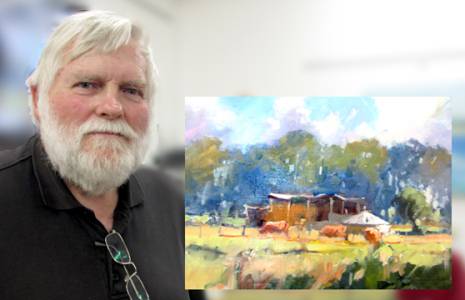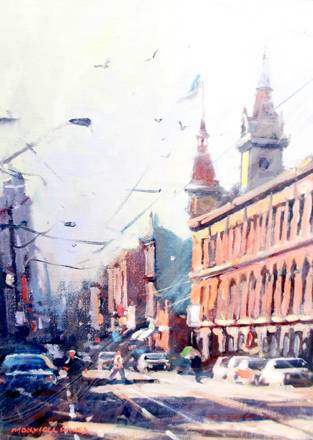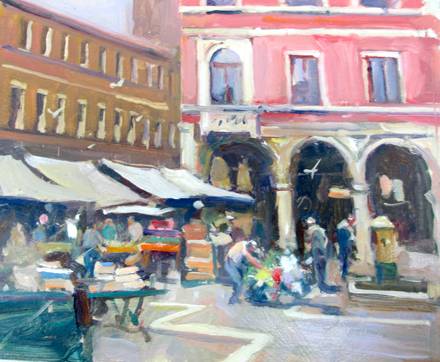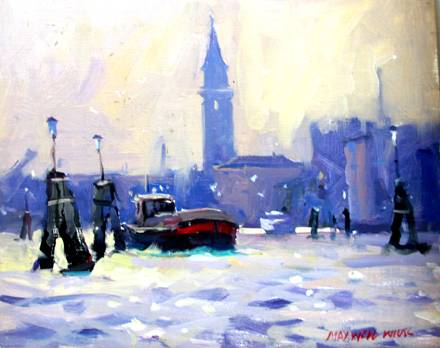Maxwell Wilks
Demonstration
Saturday 15th June, 2013
Oils Ė Landscape
 Maxwell
Wilks is a gentle, sensitive artist who gives an impression of shyness at
first but revealed that he was quietly confident in all things artistic,
based on many years of producing top level painting. He has been a
professional artist since 1980 and is most enthusiastic about his work. He
is a master of both oils and pastels, and no doubt very handy with
watercolour and drawing. He is a long term member of the Twenty Melbourne
Painters, which is a great honour when you look at the quality and history
of the other members. They have an annual exhibition at Glen Eira Town
Hall. Donít miss it.
Maxwell
Wilks is a gentle, sensitive artist who gives an impression of shyness at
first but revealed that he was quietly confident in all things artistic,
based on many years of producing top level painting. He has been a
professional artist since 1980 and is most enthusiastic about his work. He
is a master of both oils and pastels, and no doubt very handy with
watercolour and drawing. He is a long term member of the Twenty Melbourne
Painters, which is a great honour when you look at the quality and history
of the other members. They have an annual exhibition at Glen Eira Town
Hall. Donít miss it.
 Today
he did a quarter sheet size reproduction of a painting that he had done
before of a Kinglake country scene with a few farmhouses. The board was
prepared with a linen canvas of good quality ($150 per metre) glued to it.
It was fairly smooth. His pencil sketching was just that, sketchy. He
places less importance on a tight drawing, more on being free to develop
the painting as he goes along. He told us about his methods. Using a
propelling pencil with a 2B lead he does a lot of preparatory drawing,
more mass than outline. He is the sort of artist who squints a lot to get
the masses right. Photographs of the subject are useful but sketches are
better, looser, as they are tied to your memories of the day.
Today
he did a quarter sheet size reproduction of a painting that he had done
before of a Kinglake country scene with a few farmhouses. The board was
prepared with a linen canvas of good quality ($150 per metre) glued to it.
It was fairly smooth. His pencil sketching was just that, sketchy. He
places less importance on a tight drawing, more on being free to develop
the painting as he goes along. He told us about his methods. Using a
propelling pencil with a 2B lead he does a lot of preparatory drawing,
more mass than outline. He is the sort of artist who squints a lot to get
the masses right. Photographs of the subject are useful but sketches are
better, looser, as they are tied to your memories of the day.
 He
uses various brands of paint, Rembrandt, Daniel Smith. Holbein brushes are
good. Mainly flats. It is worth while taking good care of your brushes,
washing them in hot water and soap after each use. Rather than having a
clutch of brushes poking up through the hole in his palette he seemed to
use one brush which he kept cleaning on a piece of rag. He goes through
lots of rags. I remember David Chen going through lots of squares of
phonebook paper to achieve the same thing.
He
uses various brands of paint, Rembrandt, Daniel Smith. Holbein brushes are
good. Mainly flats. It is worth while taking good care of your brushes,
washing them in hot water and soap after each use. Rather than having a
clutch of brushes poking up through the hole in his palette he seemed to
use one brush which he kept cleaning on a piece of rag. He goes through
lots of rags. I remember David Chen going through lots of squares of
phonebook paper to achieve the same thing.
His palette had two little bowls attached, one for turpentine, one for linseed oil or a medium such as Liquin or Standoil. It depends on whether you want a quick dry or not as to which medium you use. Turps gives a thin quick result, the oils have a slower drying time. You can do a turps undercoat one day and add oil the next day. You can paint oils over acrylics (when dry) but not vice versa. The range of colours he puts on his palette remains fairly constant. There are no browns on his palette.
 Getting
into it, he made light, quick, sketchy marks with a small brush. The darks
go in first. Put in the big masses first, not the little bits. Donít
correct any edges at this stage. Do that later on. He uses his fingers and
a rag. He virtually draws with a rag. Rather than using white paint to put
in his light areas, he rubs back with the rag so that the canvas shows
through as the lights. This helps prevent the painting from getting muddy.
He said,Ē If you are not getting it right rub it out and start againĒ.
Obviously muddiness is a sin. Of course in the finished painting the light
areas are not just exposed canvas but properly painted. They might be the
luscious bits. Icing on the cake. Resist. Donít put them in too soon. Wait
and reward yourself later. But not too many pure whites. They are
distracting, making the eye flick around everywhere.
Getting
into it, he made light, quick, sketchy marks with a small brush. The darks
go in first. Put in the big masses first, not the little bits. Donít
correct any edges at this stage. Do that later on. He uses his fingers and
a rag. He virtually draws with a rag. Rather than using white paint to put
in his light areas, he rubs back with the rag so that the canvas shows
through as the lights. This helps prevent the painting from getting muddy.
He said,Ē If you are not getting it right rub it out and start againĒ.
Obviously muddiness is a sin. Of course in the finished painting the light
areas are not just exposed canvas but properly painted. They might be the
luscious bits. Icing on the cake. Resist. Donít put them in too soon. Wait
and reward yourself later. But not too many pure whites. They are
distracting, making the eye flick around everywhere.
It was an excellent, informative demo. The audience was really well-pleased by it. Thank you Maxwell.
Colin Browne, WAA Secretary